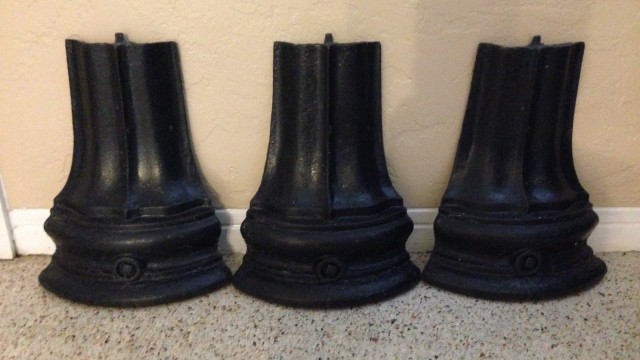
Reynolds Advanced Materials – Orlando’s Spotlight is on Jordan Chapman – a mold maker and caster. Chapman creates many super hero masks, but this spotlight is capturing his process to recreate an original cast iron lamppost cover that will blend right in with the rest of the lamppost.
For this project Jordan chose to use Task 15, Free Form Air, and Mold Max Stroke. He has documented his steps below …
Step One:
I measured the original cover, which by the way is cast iron and very, very heavy, so I could have an idea of how much material would be needed for the job.
Step Two:
Once I knew what materials I needed, and how I would go about molding it, I cleaned (washed, sanded) the original. I did not over do this step, as I wanted the mold to reflect a lot of the patina, wear and tear of the vintage piece.
I then filled all the undercuts, and open areas around the sides of the piece with clay, this is so the silicone will not seep under the piece and end up locking itself inside a giant block of silicone.
Once this was done, I built a retaining wall out of clay, using small nubs to act as keys later for the mother mold. This wall is to keep the silicone from flowing out to far, as you want a nice wall around the base.
Step Three:
Once the piece was prepped for molding, I carefully measured out the silicone I would use for each layer. I used Smooth-On’s Mold Max Stroke, and created 3 layers for this particular mold. Each layer was tinted to differentiate it from the last one (to insure good coverage), each coat was also thickened with an agent to fill in the undercuts, and give general thickness overall. The first coat however, is very thin, and is used to capture all the detail. It is the most important layer.
Step Four:
After the silicone has fully cured, I then removed the clay wall from around the edges of the silicone, and trimmed any spillage that may have occurred away; this is in preparation of for the hard mother mold.
Step Five:
I then mixed up a batch of Smooth-On’s Free Form Air, a play-dough like substance that cures to a hard, but lightweight shell. This is then used to cover the silicone mold, it acts as a rigid support for when I have to slush cast the resin inside. This way it helps the silicone have structure and keep its shape.
Step Six:
I then removed the hard mother mold, and then removed the silicone mold from the lamppost base cover itself. Pictured below (Step 6-Photo1) is the mother mold, silicone mold and original piece. Excuse the wood fibers, they stuck to the mold, but are outside the actual area that is used for creating copies, so it really does not affect anything.
Step Seven:
I then cleaned out the silicone mold with alcohol, let it dry for a day or so, then applied a release agent and placed the silicone mold back into the Free Form Air mother mold. I then proceeded to mix up a batch of Task 15 resin, and tinted it with black colorants, so there would be minimal painting to do. I then poured this into the silicone mold and cradled the mold in my arms as I rotated the mold around causing the resin to flow into all the nooks and crannies, I did this for about 10 minutes for each layer, 10 minutes being the time it took to start kicking (hardening). I did 3 layers for each cast. Pictured below (Step 7 – Photo 1 and 2) are shots of the various layers being built up.
Step Eight:
Here you can see the original next to the copies that were made. Note, since I did not want to change the surface texture of the original, some of the paint was removed when I de-molding the original. This is why some rust can be seen, but otherwise the casts are mirror copy of the original, down to the sheen, patina, paint chips, you name it.
Final Step:
All that’s left to do is paint the casts, and install them onto the base of each lamp post using brackets, hinges, or whatever method the client so chooses, as this urethane plastic can be tooled, drilled, sanded, etc. It is very durable, lightweight and has some flex to it.
![[Return to Homepage]](/assets/imgs/RAMlogo.png)


















